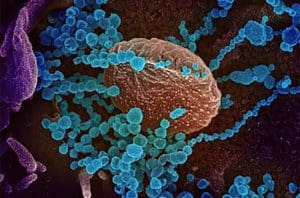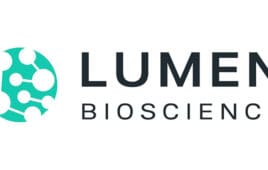
This colorized scanning electron microscope image shows SARS-CoV-2 (round blue objects), the virus that causes COVID-19, emerging from the surface of cells cultured in the lab. [Image courtesy of National Institute of Allergy and Infectious Diseases]
The illnesses were consistent with both COVID-19 and common seasonal illnesses, but the report fuels speculation that the scientists at the Wuhan lab were among the first to contract the SARS-CoV-2 virus.
The disclosures have heightened calls for an independent probe into the origin of the pandemic because the Wuhan Institute of Virology has researched coronaviruses. The time frame of the workers’ hospital visits coincided with the beginning of human-to-human transmission of the virus in Wuhan. Researchers confirmed the first case of the virus on Dec. 8, 2019.
The World Health Organization (WHO) has not entirely dismissed the lab-leak hypothesis but has concluded that it is “extremely unlikely.” The WHO is, however, continuing to investigate the pandemic’s origins.
The Wuhan Institute of Virology has not made raw data, safety logs and lab records available pertaining to its research on bat coronaviruses. Wang Yanyi, the lab director, has dismissed such theories as ‘pure fabrication’ in 2020. Yanyi said the lab received the first report of unknown pneumonia on Dec. 30, 2019, and that the lab had never encountered the virus before. “How could it have leaked from our lab when we never had it?” she asked.
China’s U.S. embassy dismissed the possibility that the Wuhan Institute of Virology was the source of the virus, pointing to a statement from the institute from March 23 stating that it had not been exposed to COVID-19 before December 30, 2019. Furthermore, the institute said it has kept a “zero-infection” record for its staff and graduate students.
“This January, the China-WHO joint mission made field trips to institutions including the Hubei Provincial Center for Disease Control, the Wuhan Center for Disease Control and the Wuhan Institute of Virology, and visited biosafety laboratories and had in-depth and candid exchanges with experts there,” said Chinese Foreign Ministry’s spokesperson Zhao Lijian. WHO members unanimously agreed that the lab leak scenario was doubtful through these field trips and visits, Lijian said. “Member of the joint mission Peter Daszak said during an interview with American media that they were able to have in-depth exchanges with authoritative experts in the Wuhan Institute of Virology with a level of openness even he hadn’t anticipated, when the claim of lab leaking was politicized on a global scale,” Lijian said.
Lijian also highlighted that the possibility that the virus first emerged outside of China. “Meanwhile, I also want to point out that there are increasingly more reports on the virus and COVID-19 pandemic being spotted in various places around the world early in the second half of 2019, and that the international community is highly concerned about the questions around the biological lab at Fort Detrick and the real intentions of the U.S. establishment of 200-plus overseas bio-labs,” he said.
Chinese authorities have questioned the U.S.’s willingness to entertain the lab-leak scenario. “We hope that the relevant departments in the U.S. will make a clarification and explain [its position] to the world as soon as possible,” Lijian said.
A spokeswoman for the National Security Council recently told the Wall Street Journal that the U.S. government has “serious questions about the earliest days of the Covid-19 pandemic, including its origins within the People’s Republic of China,” but that the government was still unsure about the source of the pandemic.
Former FDA Commissioner Dr. Scott Gottlieb recently told CNBC that he believes there is growing circumstantial evidence that the virus leaked from a lab. “The question for a lot of people is going to be when are too many coincidences too much? When does it just seem that there are too many things suggesting that this could have come out of a lab?” he asked.
Gottlieb said that it would likely be impossible to confirm if the virus did emerge from a lab. “If there were retained samples from those people who were infected in that lab, I don’t think they are available anymore,” he said.
Chinese officials have highlighted the possibility that the pandemic may have originated outside of Wuhan. They have called for an investigation into early COVID-19 outbreaks outside of its borders. Beijing has argued that the virus may have first emerged from the Fort Detrick army base in Maryland. Facilities there focus on biological defense.
Filed Under: Infectious Disease





Tell Us What You Think!
You must be logged in to post a comment.